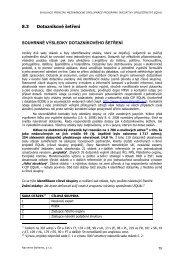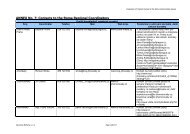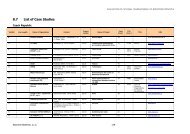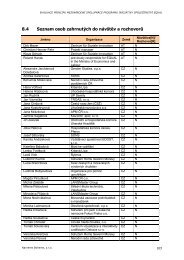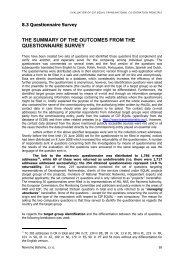EQUAL - Final report - eng - navreme
EQUAL - Final report - eng - navreme
EQUAL - Final report - eng - navreme
You also want an ePaper? Increase the reach of your titles
YUMPU automatically turns print PDFs into web optimized ePapers that Google loves.
8.8 Template for Case Studies<br />
EVALUATION OF CIP <strong>EQUAL</strong> TRANSNATIONAL CO-OPERATION PRINCIPLE<br />
CASE STUDY NO. --/COUNTRY<br />
„Evaluation of CIP <strong>EQUAL</strong> transnational co-operation principle“<br />
Section I: Information about the organization, DP, and TCA<br />
Organization name Organization you interviewed – point of view for the CS<br />
Address<br />
Legal form, size, type<br />
Project Title and no. National project, i.e. DP<br />
Project / TC website<br />
Project Duration National project, i.e. DP duration / duration of TC if differs<br />
DP Coordinator<br />
TCA name/s and no.<br />
TC Coordinator/s Who was a secretary for given TCA/s<br />
TC Partners Number of partners: Name, country, name of the national DP<br />
Section II: TCA<br />
Objectives How were TC objectives formulated in the plan and what was the reality, what<br />
makes the difference and why. How were TC objectives connected with national DP<br />
objectives, what were the expectations of DPs and TC partners? How TC objectives<br />
influenced DP objectives and vice versa.<br />
Activities How did TC partners achieve TCA objectives, what were the activities which<br />
provided the most of the TC success? What activities where unsuccessful and why?<br />
What is recommended by TCA members to include in TC activities?<br />
Outcomes What was the real outcome from the TC?<br />
Budget Budget for entire TC, share of it by interviewed organization, budget for DP and %<br />
of it dedicated to TC - Estimate in % is enough (reality! not the original plan from<br />
the TCA, commentary why the budget increased/decreased, was the share of TC<br />
financing equal, why not, did it cause any problems etc.)<br />
Ultimate beneficiaries<br />
(target groups)<br />
Who benefited from the TC? Only TCA members? National DP partners? Politicians?<br />
DP target groups? What role had local players in negotiations? How results from<br />
TCA filtered down to the level of national activities?<br />
Crucial tests What chall<strong>eng</strong>es did the TC faced<br />
Sustainability Is there any intention to continue with started TC and activities, and why yes/not<br />
Section III: Environment<br />
Influences social problems and chall<strong>eng</strong>es which had inspired the project, motivations, role of<br />
those not directly involved in the TC or national project<br />
History origins of the initiative, contacts, where did they found partners / contacts /<br />
information, criteria for matching (selecting partners) (goals, values, countries,<br />
previous experience, type of organization… etc.), estimation of the l<strong>eng</strong>th of<br />
necessary incubation period, involvement of national partners, policy makers and<br />
other players in the establishment of the TC<br />
Criteria for setting up TC criteria for allocation of responsibilities<br />
rules<br />
<strong>EQUAL</strong> environment Managing authority support, use of National support structure, National thematic<br />
networks, <strong>EQUAL</strong> guides, etc. – requirements, quality of support, constrains,<br />
recommendations<br />
Navreme Boheme, s.r.o. 130



